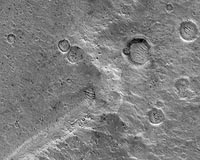 |
Moffett Field CA (SPX) Dec 14, 2009 For the very first time, the Martian moons Phobos and Deimos have been caught on camera together. ESA's Mars Express orbiter took these pioneering images last month. Apart from their 'wow' factor, these unique images will help the HRSC team validate and refine existing orbit models of the two moons. The images were acquired with the Super Resolution Channel (SRC) of the High Resolution Stereo Camera (HRSC). The camera took 130 images of the moons on 5 November at 9:14 CET over period of 1.5 minutes at intervals of 1s, speeding up to 0.5-s intervals toward the end. The image resolution is 110 m/pixel for Phobos and 240 m/pixel for Deimos - Deimos was more than twice as far from the camera. The Super Resolution Channel of the HRSC uses an additional lens, which has a very narrow field of view of just 0.5 degree, providing four times the resolution of the HRSC color stereo channel. Phobos, the larger of the two moons, orbits closer to the Red Planet, circling it every 7 hours and 39 minutes. It travels faster relative to Mars than the Moon relative to Earth. It was 11,800 km from Mars Express when the images were taken. Deimos was 26,200 km away. It is not often that both Martian moons are located directly in front of the camera, lined up one behind the other. The chance to image both moons together came on 5 November 2009 when the viewing geometry was especially favorable. The plan to image both moons at once was years in the making and was made possible by the unique elliptical orbit of Mars Express, precise knowledge of the orbits of the planet, the moons and the spacecraft, as well as fortuitous viewing geometry, and perfect planning by the ESA and HRSC teams.
Exploration of Phobos: A Scientific Priority for Mars Express The moons of Mars still hold many mysteries. Phobos is made of dark material that does not reflect much light, and some scientists suspect it has a chemical composition similar to that of carbonaceous chondrite asteroids. Phobos may also contain water ice, which could be an important resource for future Mars explorers. As missions like Mars Express continue to observe Phobos and Deimos, scientists hope to reveal more information about these unique satellites of Mars. Share This Article With Planet Earth
Related Links Mars Express Mars News and Information at MarsDaily.com Lunar Dreams and more
 Distal Rampart Of Crater In Chryse Planitia
Distal Rampart Of Crater In Chryse PlanitiaPasadena CA (SPX) Nov 18, 2009 Impact craters on Mars are kind of neat. Many of them look very different than impact craters seen on Earth's moon or Mercury. Fresh lunar and Mercurian craters have ejecta blankets that look a bit rough near the crater rims; around larger craters, long rays or chains of secondary craters radiate away from the crater rims. Some Martian craters are similar to these craters, but Mars also ha ... read more |
|
| The content herein, unless otherwise known to be public domain, are Copyright 1995-2009 - SpaceDaily. AFP and UPI Wire Stories are copyright Agence France-Presse and United Press International. ESA Portal Reports are copyright European Space Agency. All NASA sourced material is public domain. Additional copyrights may apply in whole or part to other bona fide parties. Advertising does not imply endorsement,agreement or approval of any opinions, statements or information provided by SpaceDaily on any Web page published or hosted by SpaceDaily. Privacy Statement |